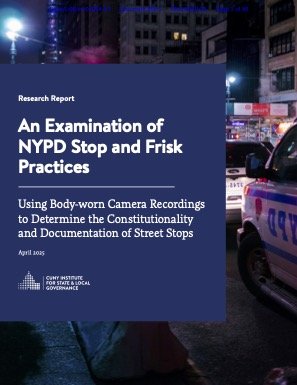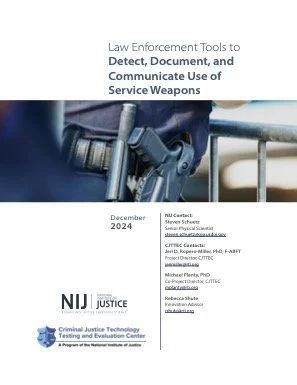By Kathleen Doherty and Annie Chen
In 2013, the United States District Court for the Southern District of New York (SDNY) ruled that stop and frisk practices employed by the NYPD were unconstitutional, specifically violating the Fourth Amendment protections against search and seizure as well as the Fourteenth Amendment’s equal protections under the law due to the discriminatory nature of the stops. A Monitor was installed to oversee compliance, and in 2021, CUNY ISLG was brought in to conduct a study using information captured on body-worn cameras (BWCs).
The CUNY ISLG study examined police encounters recorded by BWCs over a two-month period in 2022 to assess how frequently stops were constitutional. The study also assessed whether police were appropriately documenting stops. The overarching goal of the study was to provide information on the NYPD’s compliance with court-ordered reforms in three primary focus areas. See the executive summary and full report for the complete findings, but select findings, by focus area, are:
Constitutionality of stops and frisks. The study assessed how frequently officers who conduct stops violate the Fourth Amendment, examined the conditions in which unconstitutional stops occur, and identified the reasons a stop was unconstitutional.
Seventy-two percent of the stops were constitutional and 19 percent unconstitutional. The remaining 9 percent had either no consensus or insufficient information.
Unconstitutional stops were particularly prevalent among stops conducted by officers assigned to a Neighborhood Safety Team (NST), which are special units tasked with securing illegal guns. Thirty-five percent of stops were unconstitutional when an NST officer was present compared to 16 percent of stops without one.
Differences by race and ethnicity. To assess compliance with the Fourteenth Amendment, the study examined differences in constitutionality by race and ethnicity, including by conducting statistical analysis to assess differences in the constitutionality of a stop.
Among all stops, 21 percent and 19 percent of the stops of Black and Hispanic individuals were rated as unconstitutional, respectively, compared to 11 percent of the stops of all other races.
Black and Hispanic individuals constituted 97 percent of self-initiated stops. Self-initiated stops of Black and Hispanic individuals were unconstitutional at 48 and 46 percent, respectively, compared to 15 percent of the self-initiated stops of individuals of all other races.
Full and accurate documentation of stops. The study assessed the prevalence of unreported stops and the conditions in which officers most often fail to document stops appropriately in the field.
Among encounters that are low-level (i.e. officers did not indicate that a stop, arrest, or summons occurred), 2 percent of individuals were in fact stopped but not documented by police with a stop report. While this number is small in percentage terms, it indicates a large number of unreported stops because low-level encounters (not labeled as including a stop, arrest, or summons) are extremely numerous (approximately 650,000 recordings or 200,000 encounters).
New York: CUNY Institute for State & Local Governance , 2025. 92p.






